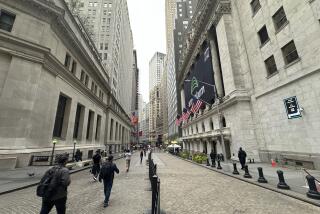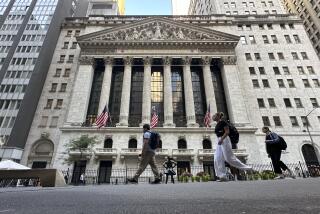Stocks tumble amid new Wall Street landscape
A stunning makeover of the Wall Street landscape sent stocks falling precipitously Monday, with the Dow Jones industrials losing more than 500 points in their worst slide since the September 2001 terrorist attacks.
The pullback, which erased about $700 billion in shareholder wealth, occurred across much of the globe as investors absorbed Lehman Bros. Holdings’ bankruptcy filing and what was essentially a forced sale of Merrill Lynch to Bank of America for $50 billion in stock.
The swift developments that took place Sunday are the biggest yet in the 14-month-old credit crisis that stems from now-toxic subprime mortgage debt. Monday’s trading followed the pattern of the last year; there were some signs of optimism, but they were dashed when investors weary of bad news perceived there was more ahead.
Troubles at American International Group, the world’s largest insurance firm, concern some investors because of the company’s enormous balance sheet and the risks that its troubles could spill over to the companies with which it does business. AIG, one of the 30 stocks that make up the Dow industrials, fell $7.38, or 61%, to $4.76 as investors worried that it would be the subject of downgrades from credit rating firms.
“We have a very, very nervous market, and folks hate uncertainty,” said Alfred E. Goldman, chief market strategist at Wachovia Securities in St. Louis. “They’ve been waiting for another shoe to drop and two of them dropped on Sunday.”
The Dow fell 504.48 points, or 4.4%, to 10,917.51, moving below the 11,000 mark for the first time since mid-July. It was the worst point drop for the Dow since it lost 684.81 on Sept. 17, 2001, the first day of trading after the terrorist attacks.
In percentage terms, the drop was the steepest since July 19, 2002. It was also the sixth-largest point drop in the Dow, just behind the 508.00 it suffered in the October 1987 crash.
The Dow is now down about 23% from its record high of 14,198.09 last October.
Broader stock indicators also fell. The Standard & Poor’s 500 index declined 59 points, or 4.7%, to 1,192.70 -- also its biggest drop since 9/11 and the first time it closed below 1,200 in three years.
The Nasdaq composite index fell 81.36 points, or 3.6%, to 2,179.91; that was its worst point loss since Jan. 4.
Declining issues overwhelmed advancers on the New York Stock Exchange, where 164 stocks rose compared with 3,064 that fell. Consolidated volume came to an extremely heavy 8.05 billion shares, compared with 6.1 billion traded Friday.
Oil closed below $100 a barrel for the first time in six months as investors worried that a slowing economy would hurt demand. Light, sweet crude fell $5.47 to settle at $95.71 a barrel on the New York Mercantile Exchange. Oil is down sharply from its mid-July highs when it hit a record of more than $147 a barrel.
Bond prices surged as investors fled to the security of government debt. The yield on the benchmark 10-year Treasury note, which moves opposite its price, plunged to 3.41% from 3.72% late Friday. The dollar was lower against other major currencies, and gold prices rose.
Other financial stocks fell as investors worried about the strength of banks’ balance sheets. Washington Mutual fell 73 cents, or 27%, to $2, while Wachovia fell $3.56, or 25%, to $10.71. Merrill rose 1 cent to $17.06, while Bank of America fell $7.19, or 21%, to $26.55.
Wal-Mart Stores fell 78 cents to $61.63, while Coca-Cola Co. rose 25 cents to $54.75.
Markets in Tokyo and several other Asian money centers were closed for holidays. Britain’s FTSE 100 fell 3.9%, Germany’s DAX index lost 2.7% and France’s CAC-40 fell 3.8%.
The Russell 2,000 index of smaller companies fell 30.50 points, or 4.2%, to 689.76.
More to Read
Inside the business of entertainment
The Wide Shot brings you news, analysis and insights on everything from streaming wars to production — and what it all means for the future.
You may occasionally receive promotional content from the Los Angeles Times.










